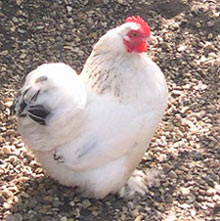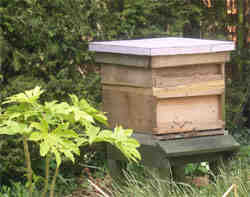How do I keep my chickens clean?
Posted by Fiona Nevile in Chickens | 200 comments Chickens are not naturally clean creatures, unlike the story book ones. Do you remember them? Clean living hens, wearing spotted scarves and venturing out to the market with a basket hooked over a wing and a clutch of chicks close by.
Chickens are not naturally clean creatures, unlike the story book ones. Do you remember them? Clean living hens, wearing spotted scarves and venturing out to the market with a basket hooked over a wing and a clutch of chicks close by.
Real life chickens will foul their chicken house and quite often foul the nesting box. The only chicken that I have known to actively ‘clean’ her house was Mrs Boss. When the guinea fowl keets hatched she pulled all the hay from her nest out of their house in the ark. The more clean hay and woodchips I added the more she pushed them into their run. After a couple of weeks, I admitted defeat. The keets slept under Mrs Boss’ wings, on bare boards. I could never understand why she did this.
If chickens are not cleaned out regularly their droppings can harbour and spread disease. Droppings in the nesting box can foul the eggs. Remove any droppings immediately from the nesting box when you see them.
There is also the question of chicken mites. In warmer weather, mites can breed like wildfire in a house that is not treated regularly. They lay their eggs in dark nooks and crannies in the house and are at their most active at night. They bite the chickens and these bites can become infected.
An imaginative Estate Agent might describe our hen house as,
“A Canadian style two storey lodge. Lower floor family room with traditional wooden slatted staircase leading to spacious communal bedroom for 8 plus with half mansard ceiling and door to cosy penthouse nesting box.”
It gets a good cleanout once a week. And a top to toe super valet and repair in the Spring and Autumn.
If you are canny, the weekly cleanout for an average sized house (ours is designed to accommodate 6-8 Maran hens) takes about twenty minutes, often it is completed in ten.
The trick to quick and easy cleaning is to store everything that you might need within a few feet of the chicken house. We keep our chicken consumables in two large barrels in the run. One holds the bedding the other contains sprays, powders, oyster shells, grit and everything that a chicken keeper might need. These storage bins are also popular with the flock as they have another vantage point on which to stand and observe the world.
Our chicken feed is stored in the boot of Danny’s car and in a large aluminium grain store in the garden. Along with the wild bird and Min Pin food.
Generally I pull on my chicken cleaning gloves at midday when the flock are out an about in the run. Initially I spray the inside of the house with a decent anti mite spray. I close the door to the house as I am not sure how safe the spray is for the flock (although it is marked suitable for an aviary with residents). While the spray wafts through the house I collect all the stuff that I need from the barrels. woodchips, fresh hay and mite powder.
The old woodchips, hay and droppings are swept into the chicken run dustpan and go into their bucket (this was sold to me as a nappy bucket and has a lid). This lid is handy as the bucket can sit happily inside the run until it is full.
Once all debris has been removed, I spread wood chips on the floor of the house. These are great as they absorb moisture and make the chicken cleaning process much easier. They are available in enormous chunky packs. and a pack lasts for months. I lay a layer of woodchips in the nesting box topped with a thickish layer of hay. My mum recommended hay for the nests as mites can breed easily in the hollow strands of straw. The hens fashion the hay into nests very quickly, even if they are off lay.
Once fresh chips and hay have been spread, I return to the barrels for oyster shells and grit. I used to put these in a nifty container in the run, now I cast them just before I open the gates to get out. The flock dives for these and before they have discovered that they are not deluxe grain mix I am the other side of the wire. Poultry need grit. Ours find this in the back wall of the run. If yours don’t have access to a wall don’t forget to provide them with grit, if you are feeding them seeds and corn as it essential for breaking down the husks in their gullets.
Chickens are fine on woodchips alone and I have seen many happy hen houses that just have newspaper spread on the floor. Once you find an effective way to keep your chickens clean that suits you, use it on a weekly basis. You and your chickens will bloom.
Leave a reply






Hi Pete
That’s a brilliant idea. I scatter it liberally on the perch and nesting boxes but I will now sprinkle it in the official bathing area – doenstairs in the hen house.
Hi Jan
Thanks for leaving a comment. Much appreciated!
Hi.
That actually sounds like a very good idea. I have heard of folks supplying a box with sand in for the chooks to bathe in but it didnt occur to me to add mite powder to it. Mine at the minute are quite happy to bathe in the soil when its dry enough but I think I might provide them with a box as well. My problem at the minute is colds but that is another subject entirely.
Thanks Pete, good tip.
hi havent posted for a while , everything is going well with the hens and could you believe i got 2 ducks for my secret santa present , ive been reading up on mites and other nasties etc ready for the warmer weather and have come across what seems to be a rather good trick regarding the mite powder , the trick says to spray and dust the run first off and dust the birds as you normally would but here comes the apparently clever bit create a dust bath for them with a deep storage type container ( keep in a dry place) half fill it with sand and mix in some mite powder they apparently do there funny rolllong around dance and pick up the dust , sand and mite powder in their feathers and as they move around dispense the mite powder for you
any thoughts
Hi Warren
If you use mite powder it’s not a problem. I clean out the hens once a week now and dust the perch and crannies with the powder. Also I dust the nesting box.
The first year that we had chickens we got mites and they bit me! We didn’t know about the powder. Since then mites havent been a problem.
Hi Lesley
Thanks for this contribution. Yes I agree rats are the biggest problem. We lock the feeder in the hen house with the chickens. Must set my traps again!
Hi Warren,
Don’t be put off. I keep my six girls on one of my 2 allotments. They have a nice big secure covered run that is attached to their nesting shed. As my allotment is fenced and I grow alot of fruit, the girls happily roam around the whole allotment when I am there. The only thing that I do find troublesome is the rats that are attracted to their food. I’ve kept them at bay by always removing the feeders at night. I get such pleasure form the girls -as well as the lovely eggs that I don’t mind all the extra effort.
Hi
Really interesting reading, ma and my son have just taken on an allotment and in the spring we were going to add some hens….but i must say that all the talk on the red mites ir really putting me off, it seems your likely to get them every year regardless of how much you clean.
I was already worried about the work involved as i’m quite heavily disabled and the thought of the mites is not good.
But i would really like to show my son we can keep hens and the benefits
Warren
Hi Jan
I haven’t had this problem yet but there is some useful information on this forum
http://www.thepoultrysite.com/forums/showthread.php?t=2651
Hi.
Can anyone give me some advice on scaley leg in chickens? My three girls are all coming up to a year old and one of them is just showing the first signs of a couple of the scales lifting on her leg. I have treated all of them at regular intervals with specialist sprays and have also used surgical spirit with the intention of preventing it from happening. Is this something that is inevitable in chooks as they get older? Or am I missing something?
Cheers
Hi MuleMarm
Oh lucky you – those first eggs are so special.
I don’t have an easy way of building nests but a friend of mine has screwed wooden wine boxes to the walls of her barn and the chickens lay in these.
Howdy Feather-Friends!
Susie.. good to hear you’re getting the mud problem solved… Thanks to Fn’s advice!
Announcing my first eggs from my first new flock! (Mama always raised them when I was a kid… I just “helped.” After I returned from City Living, I have only adopted hens already laying, ’til now.)
At Easter-time, I bought Baby Americauna’s for their colored eggs… and some mixed pullets 2 or 3 weeks of age: White Leghorns; Black Sumatras; Black Hamburgs; Silver Spangled Hamburgs; Silver Phoenix.
I had not looked in the nests for about a week, and found 6 white pullet eggs, and one brown this morning. So I’m sure they are from those mixed chicks. And the Americauna’s shouldn’t be far behind!!!
I may have a buyer for that second White Leghorn rooster who snuck in, and a few of the Americauna pullets, as I think I may have them too crowded.
Now to build those extra nests I’ve been putting off! (Anybody have good. easy instructions?)
Blessings to all… MuleMarm